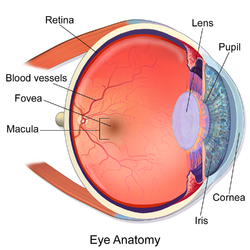Macula lutea
| Macula of retina | |
|---|---|

Human eye cross-sectional view, with macula near center.
|
|
| Details | |
| Identifiers | |
| Latin | macula lutea |
| MeSH | Macula+Lutea |
| TA | A15.2.04.021 |
| FMA | 58637 |
|
Anatomical terminology
[]
|
|
The macula or macula lutea (from Latin macula, "spot" + lutea, "yellow") is an oval-shaped pigmented area near the center of the retina of the human eye and some other animalian eyes. The macula in humans has a diameter of around 5.5 mm (0.22 in) and is subdivided into the umbo, foveola, foveal avascular zone (FAZ), fovea, parafovea, and perifovea areas. After death or enucleation (removal of the eye) the macula appears yellow, a color that is not visible in the living eye except when viewed with light from which red has been filtered. The anatomical macula at 5.5 mm (0.22 in) is much larger than the clinical macula which, at 1.5 mm (0.059 in), corresponds to the anatomical fovea. The clinical macula is seen when viewed from the pupil, as in ophthalmoscopy or retinal photography. The anatomical macula is defined histologically in terms of having two or more layers of ganglion cells. The umbo is the center of the foveola which in turn is located at the center of the fovea.
The fovea is located near the center of the macula. It is a small pit that contains the largest concentration of cone cells. The retina contains two types of photosensitive cells, the rod cells and the cones. The normal human eye contains three different types of cone, with different ranges of spectral sensitivity; hence the cones enable us to distinguish different colors. There is only one type of rod, but the rods are more sensitive than the cones, so in dim light we rely on them and do not discriminate colors. In the fovea centralis or macula lutea or simple yellow spot, cones predominate and are present at high density. The macula is thus responsible for the central, high-resolution, color vision that is possible in good light; and this kind of vision is impaired if the macula is damaged, for example in macular degeneration.
Because the macula is yellow in colour it absorbs excess blue and ultraviolet light that enter the eye, and acts as a natural sunblock (analogous to sunglasses) for this area of the retina. The yellow color comes from its content of lutein and zeaxanthin, which are yellow xanthophyll carotenoids, derived from the diet. Zeaxanthin predominates at the macula, while lutein predominates elsewhere in the retina. There is some evidence that these carotenoids protect the pigmented region from some types of macular degeneration. A formulation of 10 mg lutein and 2 mg zeaxanthin has been shown to reduce the risk of age-related macular degeneration progressing to advanced stages, although these carotenoids have not been shown to prevent the disease.
...
Wikipedia
